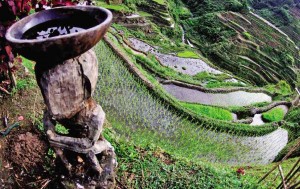Cordillera in crisis, says top NCIP official

THE BANAUE Rice Terraces may not be as antiquated as experts presumed. The latest archaeological examination of the terraces suggests these are no older than a thousand years, as modern anthropologists believed. Early studies described the terraces as 2,000 years old. EV ESPIRITU/INQUIRER NORTHERN LUZON
BAGUIO CITY—The Cordillera is in crisis because it has failed to resolve its political and social divisions on its 26th year as a region, a top official of the National Commission on Indigenous Peoples (NCIP) said during the Cordillera Day celebration here on Monday.
Zenaida Brigida Hamada Pawid, NCIP chair and the event’s guest, said the best way to describe this division was to remind the region’s leaders that the Cordillera “is continuously celebrating three Cordillera days.”
She was referring to the July 15 government commemoration of the signing of Executive Order No. 220, which created the Cordillera Administrative Region (CAR); the April 24 commemoration by the Cordillera Peoples Alliance of the 1980 murder of Kalinga chieftain Macliing Dulag who fought the construction of Chico River Dam; and the Sept. 17 celebration to remember the “sipat” (cessation of hostilities) between slain rebel priest Conrado Balweg and then President Corazon Aquino, which led to the issuance of EO 220.
“When are we ever going to be one? Are we such a people that we can’t go back to the issues and values and the system that we knew [to solve our differences]?” said Pawid, a Cordilleran.
She said the Cordillera was facing “a crisis of the green.”
“We are the watershed of northern and central Luzon, but we have given up our waters, our mountains, our trees and our minerals without even a by-your-leave of the people of the Cordillera,” she said.
Pawid said the Cordillera was also dealing with a “crisis of people” who lost “the concept of integrity, self-determination and self-sufficiency.”
“We cannot remain in the museums simply as objects of study and subjects of rebellion,” she said.
But the Cordillera keeps celebrating the region’s founding even though it has not secured the same rights afforded to Muslim Mindanao over its resources despite a 1987 peace agreement, Pawid said.
Like the Autonomous Region in Muslim Mindanao, the Cordillera is identified by the 1987 Constitution as an autonomous region.
Pawid and Baguio Mayor Mauricio Domogan, in separate speeches, discussed the new wealth-sharing deal in the peace talks with the Moro Islamic Liberation Front (MILF), which would grant a prospective Bangsamoro region a 50-percent share from petroleum and uranium developed in their territory.
Domogan said the Cordillera would have fought for control over its natural resources had the region’s congressional leaders supported a third bid to create an autonomous Cordillera region last year.
The third measure, which replaces two previous autonomy laws that were not ratified in plebiscites in 1990 and 1998, was filed in 2011, only to be tabled over questions about the financing of a new autonomous region.
“CAR is 26 years old… [For a typical family], the hardest years are the teen years … but 26 is the year when most people decide to get married and to separate from their parents. We have reached that stage,” Pawid said.
The constitutional provisions creating autonomous regions, as well as the provisions recognizing indigenous peoples’ rights, were products of the struggles of Cordillerans and their history, she said.
“It was in the Chico River Dam [struggle] that the Cordillera became known internationally, and [which was why] the word ‘autonomy’ found its way into the 1987 Constitution of the Philippines,” she said.
“It is here in Baguio where the concept of native title was won in the Supreme Court of the United States in 1916 and it remains enshrined in the law of the land, which is now called the Indigenous Peoples’ Rights Act of 1997 (Republic Act No. 8371),” Pawid added.
She said many of the people who spoke peace with Moro rebels were in fact from the Cordillera and their expertise could be tapped to help the upland region get better terms from the government.
Supreme Court Associate Justice Marvic Leonen, a Baguio native, led the government panel in the talks with the MILF. Pawid herself was a government peace negotiator under the term of former President Fidel Ramos.
“Fourteen million indigenous Filipinos look to the Cordillera, and ask us, why have we not acquired autonomy? Why haven’t we talked to the government to achieve that instead of kowtowing to its every decision? Why did the Cordillera lose its leadership over IPs?” she said. Vincent Cabreza, Inquirer Northern Luzon